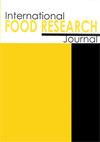乳杆菌菌株对摩洛哥山羊奶酪成熟过程中微生物学、生化和感官特性的影响
IF 0.7
4区 农林科学
Q4 FOOD SCIENCE & TECHNOLOGY
引用次数: 0
摘要
本研究的目的是研究在摩洛哥山羊奶酪中添加本地乳酸菌菌株(LAB)的影响,重点研究其在成熟过程中的微生物学和生化进化,以及对产品感官特性的影响。我们制备了三种类型的奶酪:(i)对照奶酪(CNT)通过添加由乳酸乳球菌亚种组成的发酵剂制成。乳酸菌变种二乙酰乳酸菌和乳酸菌亚种的一株。lactis;(ii)用相同的乳球菌发酵剂制成的奶酪(“LP”),并添加一株植物乳杆菌作为辅助培养物;(iii)用相同的乳球菌发酵剂制成的奶酪(“LPC”),并添加副干酪乳杆菌作为辅助培养物。除了乳酸菌在成熟过程中增加外,大多数细菌群的计数随着奶酪的成熟而减少。在整个成熟过程中,总氮、可溶性氮和可溶性氮在12% TCA含量下均最高。成熟第60天,LPC奶酪中双乙酰和乙酰的含量最高。在LP, LPC和CNT奶酪中观察到FFA的显著差异,从而表明脂肪分解延长(C4:0-C18:3 FFA)的变化可能受到所使用的发酵剂的影响。这表明这两种辅助菌株都可以生产出高质量的摩洛哥山羊奶酪。然而,添加副干酪乳杆菌培养物在改善香气强度和整体奶酪品质方面具有特别的优势。此外,脂肪分解过程不断增加,直到成熟期结束,从而证实成熟阶段是影响这些奶酪感官特性的主要因素。用辅助培养物制作的奶酪具有摩洛哥山羊奶酪的典型味道,呈现出可接受的风味,并满足通常的感官要求。本文章由计算机程序翻译,如有差异,请以英文原文为准。
Effect of Lactobacillus spp. strains on the microbiological, biochemical, and organoleptic properties of Moroccan goat’s cheese during ripening
The aim of the present work was to investigate the effect of adding autochthonous lactic acid bacteria strains (LAB) to Moroccan goat’s milk cheese, focusing on its microbiological and biochemical evolution during the ripening process, as well as on the product’s sensorial properties. We prepared three types of cheese: (i) a control cheese (CNT) made by adding a starter culture composed of a strain of Lactococcus lactis subsp. lactis var. diacetylactis and a strain of Lactobacillus lactis subsp. lactis; (ii) a cheese (“LP”) made with the same lactococcal starter culture, and adding a strain of Lactobacillus plantarum as an adjunct culture, and (iii) a cheese (“LPC”) made with the same lactococcal starter culture, and adding Lactobacillus paracasei as an adjunct culture. The counts of most bacterial groups decreased as the cheeses matured, except for lactic acid bacteria, which increased during ripening. Throughout the ripening period, LP cheese showed the highest values for total nitrogen, soluble nitrogen, and soluble nitrogen in 12% TCA. On the 60th day of ripening, the highest contents of diacetyl and acetoin were recorded in LPC cheese. A significant difference in FFA was observed among the LP, LPC, and CNT cheeses, thus indicating a change in lipolysis extension (C4:0-C18:3 FFA) that might be influenced by the starter employed. These suggested that both adjunct strains could produce high-quality Moroccan goat cheese. However, the addition of Lactobacillus paracasei culture had the particular advantage of improving aroma intensity and overall cheese quality. Moreover, the lipolysis process increased continually until the end of the ripening period, thereby confirming that the ripening phase is the main factor that affects these cheeses’ sensory properties. The cheeses made with adjunct cultures had the typical taste of Moroccan goat cheese, presented an acceptable flavour, and fulfilled the usual sensory requirements.
求助全文
通过发布文献求助,成功后即可免费获取论文全文。
去求助
来源期刊

international food research journal
Agricultural and Biological Sciences-Food Science
CiteScore
1.40
自引率
0.00%
发文量
75
期刊介绍:
The International Food Research Journal (IFRJ) publishes papers in English, six (6) issues a year with the coverage of:
Food Science and Technology
Nutrition and Dietetics
Agriculture, multidisciplinary
Chemistry, multidisciplinary
The scope of the Journal includes:
Food Science, Food Technology and Food Biotechnology
Product Development and Sensory Evaluation
Food Habits, Nutrition, and Health
Food Safety and Quality
Food Chemistry, Food Microbiology, Food Analysis and Testing
Food Engineering
Food Packaging
Food Waste Management
Food Entrepreneur
Food Regulatory
Post-Harvest Food Management
Food Supply Chain Management
Halal Food and Management
 求助内容:
求助内容: 应助结果提醒方式:
应助结果提醒方式:


